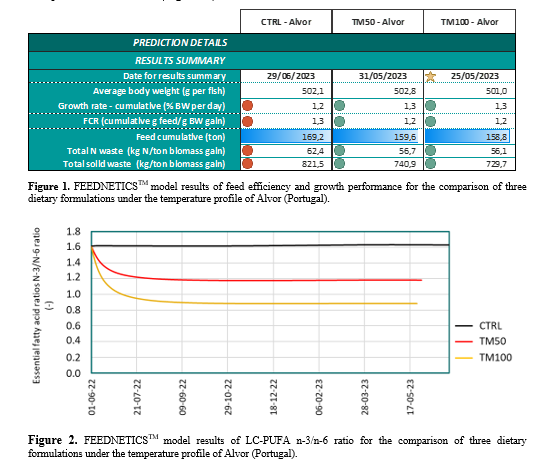FEEDNETICSTM AS A TOOL TO PREDICT THE LONG-TERM EFFECTS OF FEEDING DEFATTED Tenebrio molitor LARVAE MEAL ON EUROPEAN SEA BASS GROWTH AND BODY COMPOSITION UNDER FARM-SCALE CONDITIONS
Introduction
Since the insect protein from seven insect species was authorized by the European Union for use in aquafeeds, the interest in such ingredient has clearly emerged to both the scientific community and the aquaculture industry. In just a few years, the insect’s production industry has risen in Europe, and the Hermetia illucens (HI) and Tenebrio molitor (TM) are the main insect species produced. Consequently, they have been the most studied insect species as fishmeal (FM) substitute in diets for both freshwater and marine fish. Between both insect species, defatted (d-) TM seems more adequate to replace FM in European sea bass (Dicentrarchus labrax) (Basto et al., 2020), one of the most important fish species in Mediterranean aquaculture. However, long-term studies under farm-scale conditions are still not available. Thus, the main objective of this work was to predict the long-term effect of dTM as main protein source in diets for European sea bass reared under a farm-scale scenario, using the FEEDNETICSTM dynamic nutrient-based model smart-software.
Material and methods
A formulation with 40% (as feed basis) of FM was used as control (CTRL), and two other isoproteic, isolipidic and isoenergetic dietary formulations (47% protein, 20% fat and 24% energy), with 50% and 100% FM replacement by dTM (TM50 and TM100, respectively) were evaluated in silico. The FEEDNETICSTM was used to run predictions of a long-term trial with 300 000 European sea bass juveniles, stocked at 1/3/2021, with initial body weight of 5 g, considering a monthly mortality rate of 1% and a harvest weight of 500 g. Predictions were run considering the annual water temperature profile of Alvor (Portugal), obtained from www.fitfeedingtables.com).
Results
The FEEDNETICSTM simulations indicate that feed efficiency should be slightly higher if fish were fed with dTM formulations (Figure 1). Consequently, those fish could reach the harvest weight of 500 g in approximately 12 months, while fish fed with CTRL would require 13 months. For the considered environmental conditions, the model suggests that formulations with dTM may result in slightly lower amounts of nitrogen and solids being released into the water. It is also expected that the increase of dietary inclusion of dTM may result in a concomitant decrease of total phosphorus wastes. Despite the model does not indicate differences in whole-body crude protein and crude fat among dietary formulations, it does in fact indicate some changes in amino acids and fatty acids (FA) profile. The formulations with dTM seem to increase total saturated FA, due to increased levels of palmitic acid; have no impact on total monounsaturated FA; reduce total polyunsaturated FA (LC-PUFA), due to decreased levels of some essential FA such as arachidonic, eicosapentaenoic and docosahexaenoic acids. The predictions also demonstrated that dTM may be responsible for a marked increment of whole-body linoleic acid. Despite simulations for TM50 and TM100 indicate a LC-PUFA reduction, a fair level of n-3/n-6 ratio (1.2) was still predicted for TM50 (Figure 2.).
Discussion and conclusions
In the long-term, TM50 seems to be the most promising dietary formulation for European sea bass reared under a practical farm-scale scenario. Overall, results of predictions based on this feed reflect a good balance between feed efficiency, growth performance, body composition and environmental outputs. The use of FEEDNETICSTM proved to be a useful tool to predict the outcome of nutritional trials. However, simulations still need to validated simulations through pilot scale trials.
Acknowledgements
The authors would like to extend their gratitude towards SPAROS Lda. (Portugal) for providing the FEEDNETICSTM academic licence used in this study. AB was financially supported by FCT (Portugal), through the grant SFRH/BD/138593/2018.
